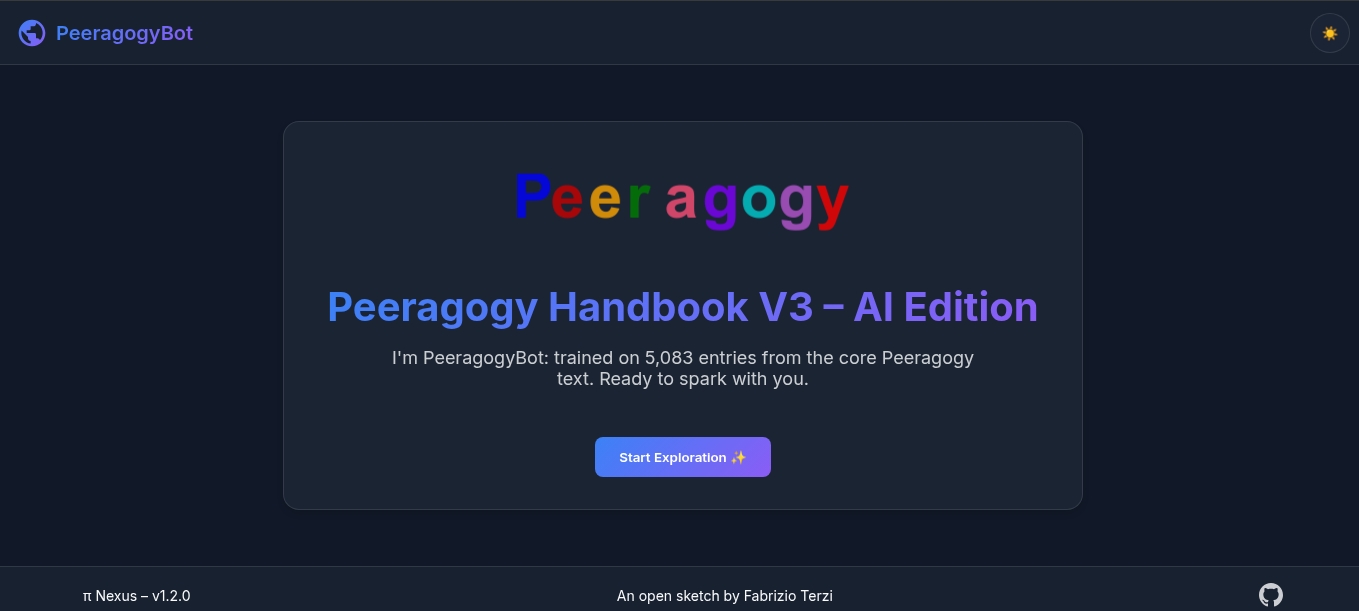Your AI Partner in Peer Learning
An AI companion designed to enhance peer learning through reflection and co-creation, trained on the Peeragogy Handbook.


April 1, 2025 — by Fabrizio Terzi
1-Chat with the Bot 2-View on GitHub
What is PeeragogyBot?
Section titled “What is PeeragogyBot?”PeeragogyBot is an open-source conversational AI assistant specifically designed to support peer learning (peeragogy) in the age of artificial intelligence. Think of it as a guide, a reflective partner, and a co-creative agent rolled into one.
Trained on the extensive knowledge base of the Peeragogy Handbook V3 – AI Edition (5,083 entries!), the bot embodies peeragogical principles. It doesn’t just provide answers; it encourages deeper thinking, helps articulate ideas, and facilitates collaborative exploration of topics.
It’s built for communities, classrooms, and any group aiming to learn more effectively together.
Core Features
Section titled “Core Features”- 💬 Conversational Interaction: Engage in natural language dialogues. Ask questions, explore concepts, and let your curiosity lead the way.
- 🧠 Reflective & Co-Creative: Designed to stimulate metacognition. It helps you reflect on your learning process and co-create understanding with peers and the AI.
- 🛠️ Modular & Customizable: Built using Flowise, allowing easy modification of prompts, tools, knowledge bases, and workflows.
- 🌐 Easily Deployable: Host your own instance locally or on cloud platforms like Railway, Render, or Koyeb. Full control over your bot.
- 🔐 Privacy-Focused: Features temporary chat logs and optional database Time-To-Live (TTL) settings. No hidden tracking or analytics.
- 📖 Knowledge-Grounded: Answers are grounded in the Peeragogy Handbook, providing contextually relevant information using Retrieval-Augmented Generation (RAG).
How It Works: The Tech Behind the Bot
Section titled “How It Works: The Tech Behind the Bot”PeeragogyBot leverages a modern AI stack orchestrated by Flowise, an open-source UI visual tool for building customized LLM flows.
The core components include:
User Input ↔️ [Flowise UI/API] ↕️+------------------------------------+| Flowise Workflow (ToolAgent) ||------------------------------------|| 1. Input Processing & History Mgmt || 2. Tool Selection (Conditional) || a. Retrieval (Pinecone/VectorDB)|| - Query Vector Store || - Fetch Relevant Docs || b. Reflective Prompting || c. Standard LLM Call (OpenAI) || 3. RAG Memory Integration || 4. Response Generation (LLM) || 5. Output Formatting |+------------------------------------+ ↕️ [Backend Services] - OpenAI API - Pinecone (or other Vector DB) - NeonDB (Optional: Chat History w/ TTL) ↕️ [Knowledge Base] - Peeragogy Handbook Embeddings- User Interaction: You chat via a web interface.
- Flowise Backend: Manages the conversation flow, calling different tools as needed.
- Retrieval (RAG): Queries a vector database (like Pinecone) containing the Peeragogy Handbook to find relevant text passages.
- LLM (OpenAI): Uses a Large Language Model (like GPT-3.5/4) to understand the query, process retrieved information, and generate a conversational, reflective response.
- Memory: Maintains conversation context and uses RAG to ground responses in the provided knowledge base.
- Deployment: The Flowise pipeline is deployed (e.g., via GitHub Actions) to a hosting service, making the bot accessible online.
Explore the Flowise Backend Code
Get Started: Using PeeragogyBot
Section titled “Get Started: Using PeeragogyBot”- 🔗 Visit the Bot: Go to the public instance hosted at peeragogybot.pyragogy.org.
- 💬 Start Chatting: Ask anything related to peer learning, the Peeragogy Handbook, using AI in education, or reflective practices. Try questions like: “What is the core idea of peeragogy?”, “How can AI help facilitate peer feedback?”, or “Summarize the PAR Framework”.
- 🤔 Explore & Reflect: Notice how the bot encourages you to think deeper. Use it as a sounding board or a tool to explore the handbook’s concepts.
For Developers & Contributors
Section titled “For Developers & Contributors”PeeragogyBot is an open-source project, and we welcome contributions!
You can:
- Fork the Repositories: Get the code for the Chatbot UI and the Flowise Backend.
- Customize Your Instance: Modify the system prompts, integrate different tools, change the knowledge base (use your own documents!), or adjust the data logging settings (e.g., MongoDB TTL for session storage).
- Deploy Your Own Bot: Follow the instructions in the repositories to deploy the bot on platforms like Railway, Render, Koyeb, or locally.
- Contribute Back: Report issues, suggest improvements, or submit pull requests to enhance the bot’s capabilities or documentation.
Bot UI Repository · Flowise Backend Repository
Privacy & Data
Section titled “Privacy & Data”We respect your privacy. The public instance of PeeragogyBot uses temporary chat logs for context during a session. If persistent storage (like MongoDB) is configured in a deployment, it includes Time-To-Live (TTL) features to automatically delete data after a specified period. We do not use hidden analytics or tracking.
Join the Pyragogy Project
Section titled “Join the Pyragogy Project”PeeragogyBot is part of the broader Pyragogy Open Source Initiative, aiming to build tools and practices for effective peer learning in the digital age.
Connect with the community, explore other projects, and help us reimagine learning—together, with AI.
Built with Flowise, OpenAI, and the Peeragogy Handbook.
Open Source (Specify License Type if known, e.g., MIT License)